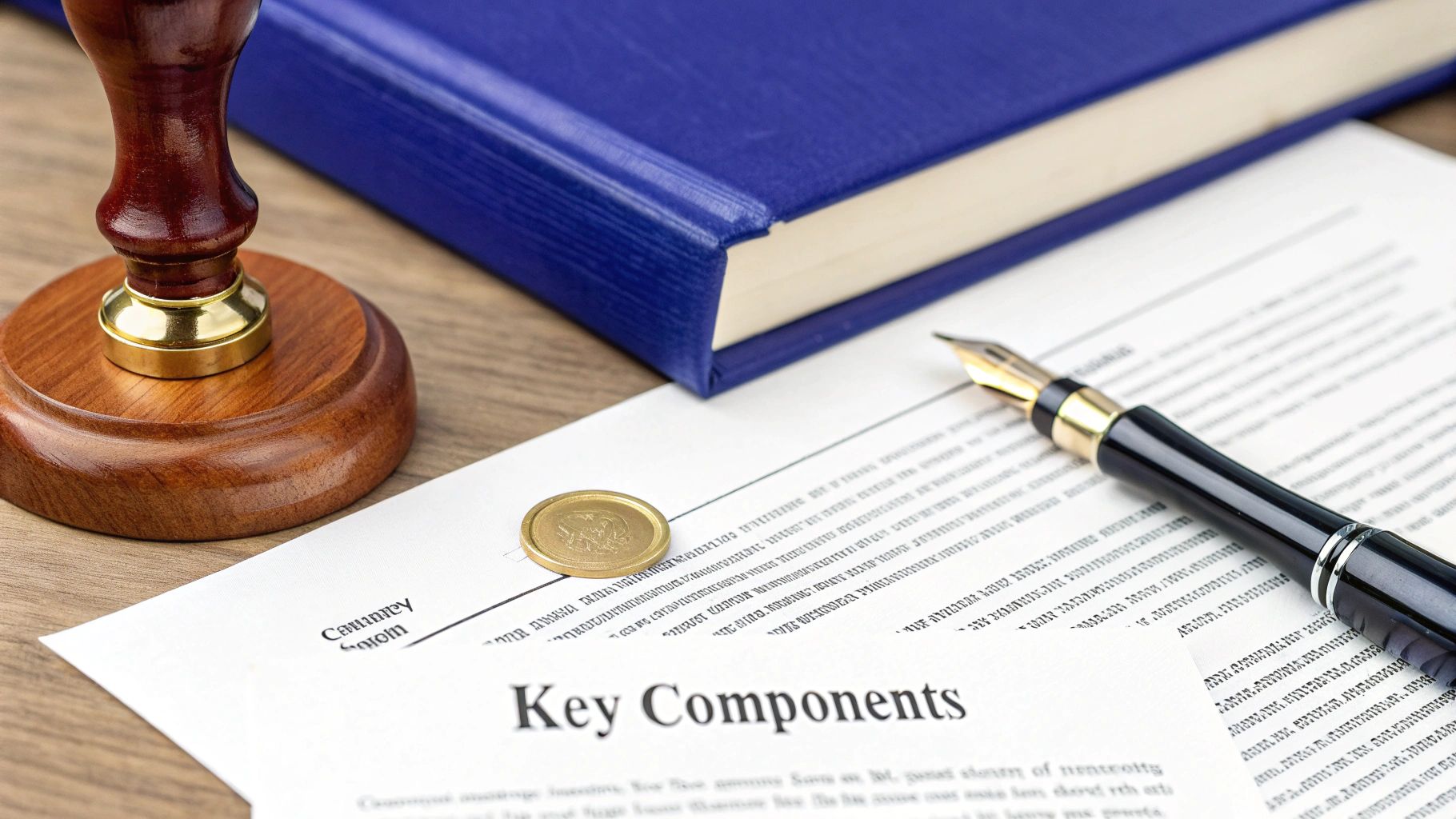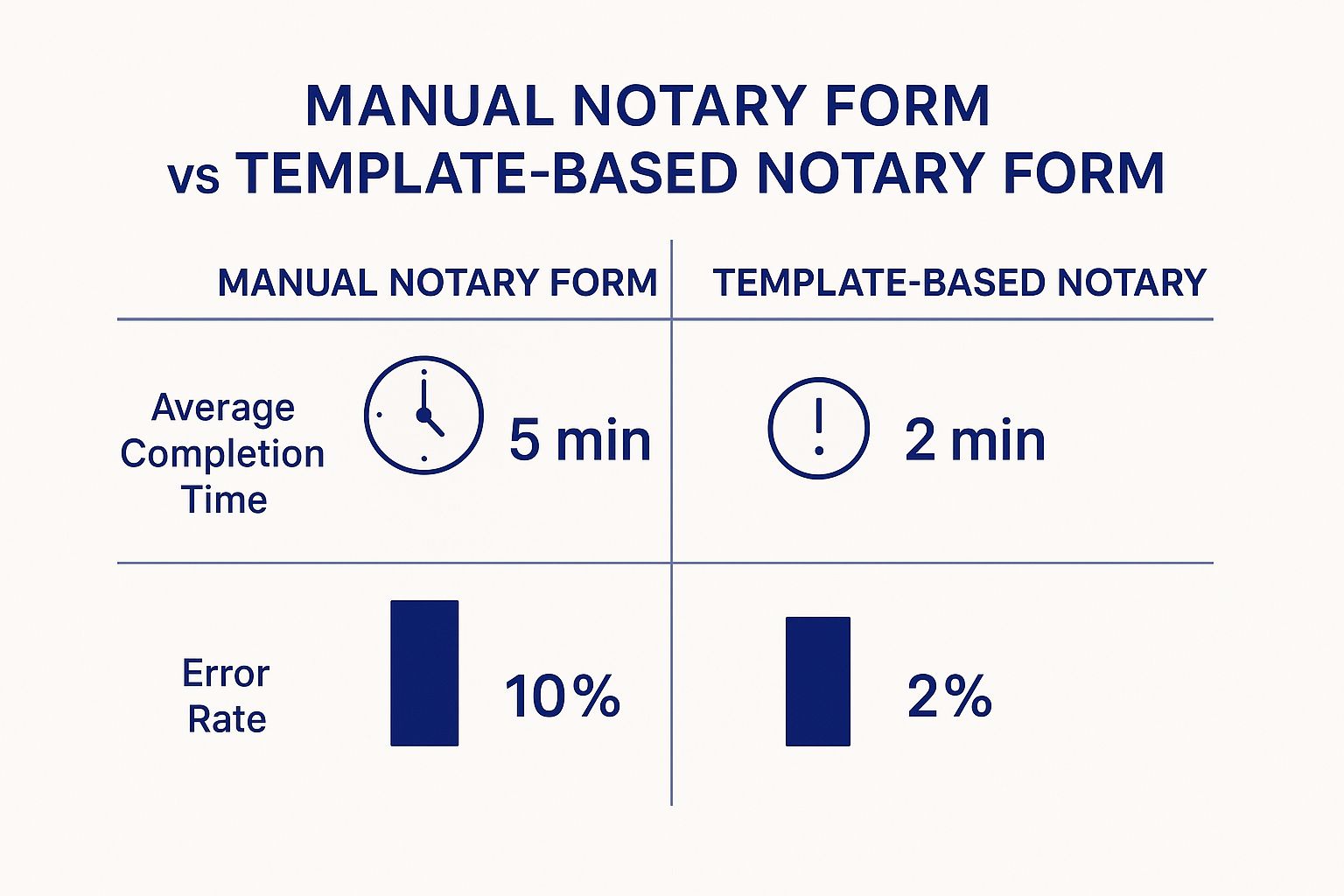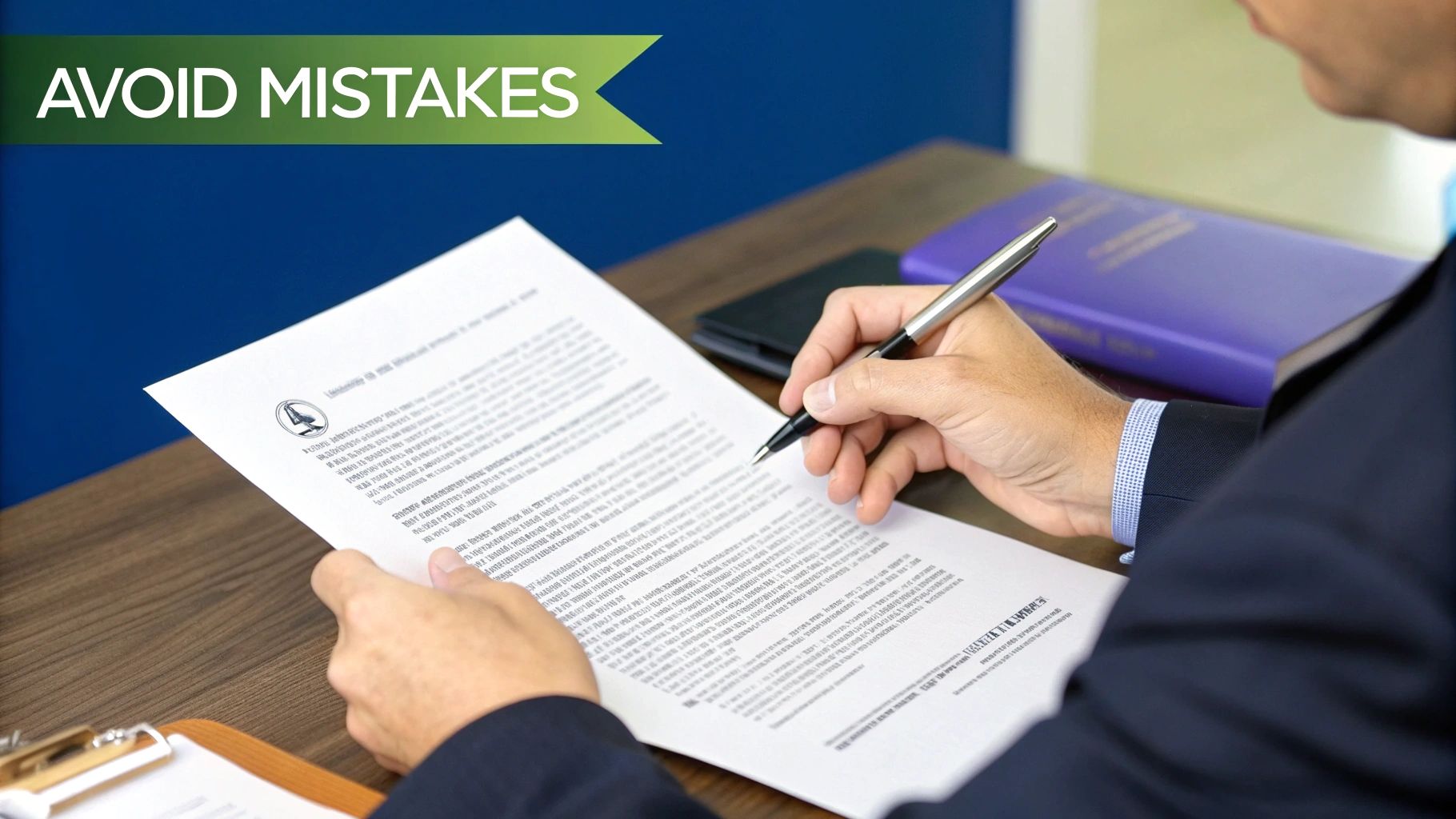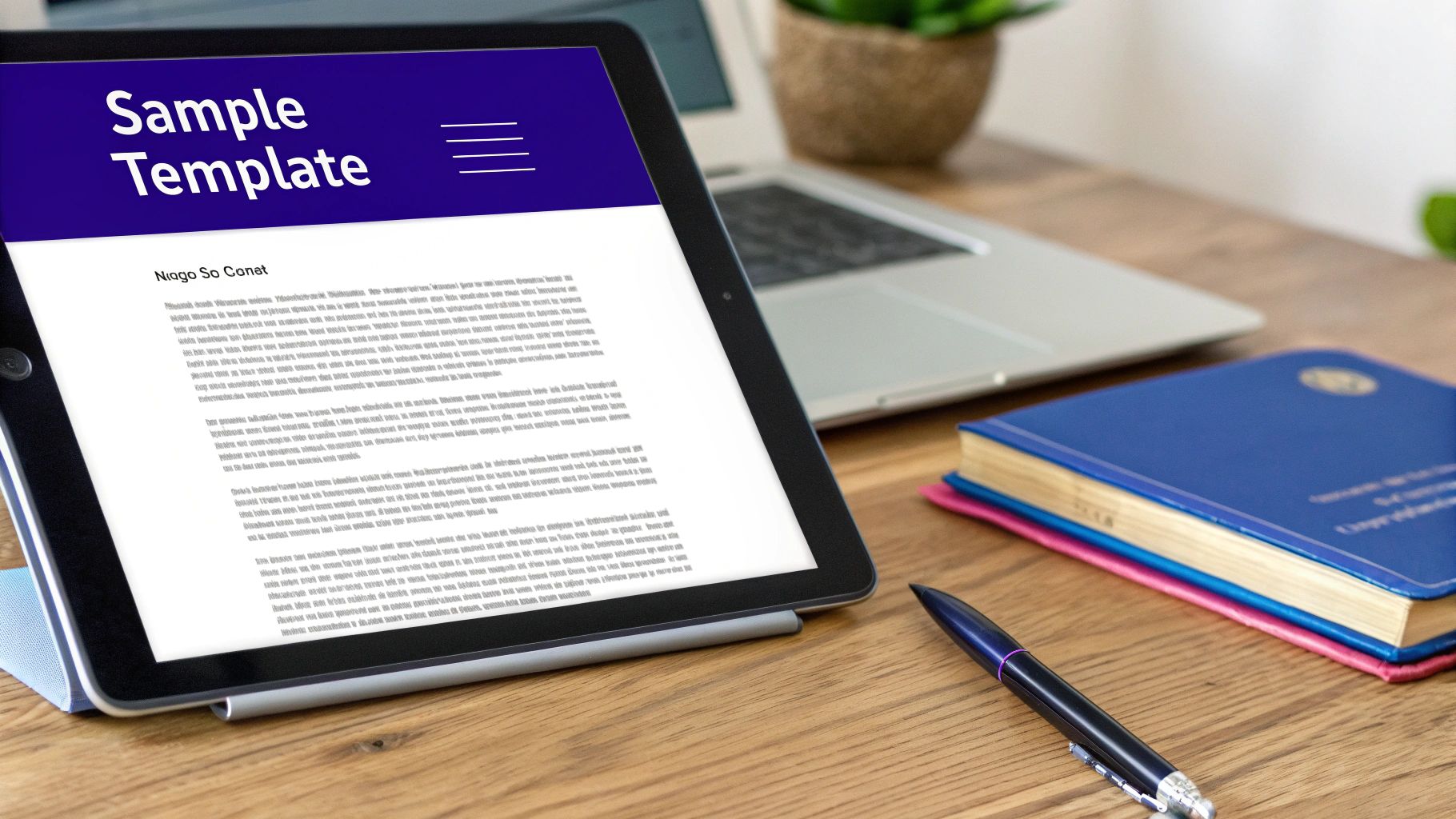Your Guide to Template Notary Statements
- WebsiteFix Technical Partner
- Jul 12
- 13 min read
A template notary statement is a pre-written certificate that a Notary Public fills out and attaches to a document after a signing. You might hear it called a notary certificate. It’s not actually part of the client's document; think of it as your own official, sworn statement about the notarial act you just completed. Using the right template is a cornerstone of your practice, essential for staying compliant and protecting everyone involved.
What Exactly Is a Template Notary Statement?
Before you notarize another document, let's get crystal clear on what a template notary statement really is. It’s far more than a simple form—it's your legal testimony in writing. This certificate is the primary safeguard for the signer, the public, and just as critically, for you as a commissioned Notary. A properly filled-out statement is what gives a notarization its legal weight.
Your certificate confirms that you, an impartial official appointed by the state, followed the law to verify the signer's identity and witness the specific notarial act. Without this attached certificate, the notarization is incomplete and has no legal standing.
The Role of a Notary Certificate
A template notary statement isn't just another piece of administrative work; it's the very heart of your professional duty. Its main purpose is to create a permanent, legal record of the notarization you performed.
This record accomplishes a few key things:
Acts as a Legal Shield: For you, the Notary, a correctly completed certificate is your best defense if your work is ever questioned or challenged in court.
Provides Public Trust: It tells anyone who receives the document—a court, a bank, a government agency—that the signing was handled professionally and the document can be relied upon.
Protects the Signer: It’s a powerful tool against fraud, confirming that the signer personally appeared before you and executed the document on a specific date.
Here's a common point of confusion I see all the time: many people think the notary statement is part of the document they're signing. It's not. It's a separate attachment that you complete and are solely responsible for. Your liability is tied to the certificate, not the document's contents.
Foundational Elements of Every Statement
While the precise wording will change based on your state's laws and the type of notarial act, every notary certificate shares a few non-negotiable components. Getting these right is the first step to a perfect notarization, every single time.
You'll always see a space for the venue. This is simply the location (State and County) where the notarization is taking place. It's a must-have and has to be accurate. The other core element is the specific notarial wording for an acknowledgment, jurat, or other act. This language is the blueprint for the entire ceremony—it dictates what you say to the signer and how they must sign.
Once you have a solid grasp of these basic building blocks, you'll be able to confidently choose and fill out the correct template for any situation, ensuring you’re always compliant and successful.
What Makes a Notary Certificate Legally Bulletproof?

It’s a scenario every notary dreads: a small, overlooked error on a certificate that brings a crucial transaction to a grinding halt. A single mistake can invalidate the entire document, and believe me, it happens more often than you'd think. Think of your notary certificate as a precise legal formula. Miss one element, and the whole thing falls apart.
Understanding what goes into a compliant template notary statement is your best defense against liability and document rejection. Let’s break down the anatomy piece by piece, so you can be confident that every notarization you perform will stand up to scrutiny.
The Foundation: Where, When, and What
The top of any notary certificate sets the stage for the entire act. This is the first thing a receiving agency or county clerk looks at, and it’s where mistakes are most commonly found.
Venue (Location): This is always the state and county where the notarization physically takes place. It’s not where the document was drafted or where it’s headed. If you’re meeting a signer at a coffee shop in a different county, you use that county.
Date of Notarization: This is the exact calendar date the signer personally appeared before you. Backdating or post-dating is a serious offense and can get your commission revoked. No exceptions.
Specific Notarial Wording: The body of the certificate contains the "magic words" required by your state. This language, like "acknowledged before me" for an acknowledgment or "subscribed and sworn to" for a jurat, is the legal heart of the certificate and defines the act you performed.
I once saw a real estate closing delayed by two days because the notary forgot to fill in the county. It was a simple oversight, but it created a costly headache for everyone involved. A quick double-check would have prevented it all.
Key Takeaway: The venue and date are more than just administrative details. They anchor your official act to a specific time and place, giving it legal standing. Get them right, every single time.
The demand for flawlessly executed notarial acts is soaring. Take the prenuptial agreement market, for instance. It relies heavily on standardized, compliant certificates and hit a global market size of approximately USD 4.7 billion in 2023. That figure is projected to nearly double, showing just how critical error-free notarization has become.
The Finishing Touches: Your Signature and Seal
The bottom half of the certificate is where you, the Notary Public, finalize the act. This section ties your official capacity to the document and serves as your professional endorsement.
Below is a quick-reference table that breaks down these final, crucial components. Getting these elements perfect is non-negotiable for a valid notarization.
Essential Components of a Notary Statement
Component | Purpose | Common Mistake to Avoid |
|---|---|---|
Name(s) of Signer(s) | Clearly identifies the individual(s) whose signature was notarized. | Misspelling the name or accidentally listing someone who didn't appear. Always verify against their ID. |
Notary Signature | Your official signature, which must match what's on file with your commissioning authority. | Signing with a nickname or a version of your signature that doesn't match your commission paperwork. |
Notary Seal/Stamp | Imprints your official details (name, commission number, state) onto the document. | A smudged, illegible, or expired seal. Always stamp on a flat, hard surface for a clean impression. |
Commission Expiration | States the exact date your notary commission ends, confirming your active status. | Forgetting to write it in or using an old date from a previous commission. It happens! |
These final elements are your personal guarantee that you performed your duties correctly.
To see how these parts all come together for different types of notarial acts, check out our collection of notarial certificate sample templates for 2025.
Choosing Between an Acknowledgment and a Jurat
As a Notary, one of the most critical parts of your job is guiding the signer toward the correct notarial certificate. The two you'll encounter most often are the Acknowledgment and the Jurat. They might look similar at first glance, but they have completely different legal functions. Using the wrong one can render a document invalid, so knowing the difference inside and out is essential.
It’s crucial to remember that the signer, not you, must choose the notarial act they need. Your role is to clearly explain the purpose of each one, not to provide legal advice. If the signer is still unsure which to choose, their only recourse is to contact the person or agency that issued the document or will be receiving it.
The Acknowledgment: Confirming Identity and Intent
Think of an Acknowledgment as being all about identity and willingness. With this act, the signer is simply confirming to you that they signed the document of their own free will.
A common scenario is when someone signs a real estate deed at home and brings it to you the next day. The signature is already on the page. In this case, your job isn't to watch them sign, but to:
Positively identify the individual according to your state's regulations.
Ask them to formally acknowledge that the signature on the document is theirs and that they signed it willingly.
No oath is required because the focus is purely on the signature's authenticity, not the document's contents. You'll know it's an Acknowledgment by the key phrase in the certificate: "acknowledged before me." This is why they are standard for things like contracts, deeds, and powers of attorney—documents where the main goal is to prove who signed it.
The Jurat: Swearing to the Truth
A Jurat takes things a step further. Often called a "verification upon oath or affirmation," a Jurat is about the signer swearing or affirming that the statements in the document are true. This is a much more solemn act.
For a Jurat, the signing absolutely must happen in your presence. You cannot attach a Jurat to a pre-signed document. The heart of the Jurat is the verbal ceremony.
You must administer a formal, spoken oath or affirmation. The signer must respond out loud with a clear "I do" or "Yes." A nod is not enough. This verbal commitment legally binds the signer to the document's contents, making them liable under penalty of perjury if they've lied.
The certificate wording for a Jurat will always contain the phrase "subscribed and sworn to (or affirmed) before me." This is why Jurats are mandatory for affidavits, depositions, and applications—any document where the signer is making factual claims that need to be legally binding.
To make things clearer, let's break down the key differences.
Acknowledgment vs. Jurat At a Glance
Feature | Acknowledgment | Jurat |
|---|---|---|
Purpose | To confirm the signer's identity and that they signed willingly. | To have the signer swear or affirm that the contents of the document are true. |
Verbal Ceremony | Signer acknowledges their signature. No oath is required. | Notary administers an oath or affirmation; signer swears to the truthfulness of the document. |
Typical Uses | Deeds, contracts, powers of attorney, trust documents. | Affidavits, depositions, applications, any sworn statement. |
Understanding this distinction is fundamental to performing your duties correctly and protecting the integrity of the documents you notarize.

As you can see, having pre-vetted, compliant templates for both Acknowledgments and Jurats is a game-changer. It doesn't just speed up the process; it drastically cuts down on the risk of errors. Getting the certificate right is everything, and a good template is your best tool for ensuring accuracy every single time.
Avoiding Common and Costly Notarization Errors

Even the most seasoned notaries can make simple mistakes that carry serious legal and financial weight. Relying on a template notary statement is a smart move for consistency, but it's not an ironclad defense against error. A single slip-up can get a document rejected, spark legal challenges, and leave you personally liable.
These aren't just hypotheticals. I've seen major transactions get completely derailed by a minor mistake on a notarial certificate. Picture a real estate closing grinding to a halt because of a wrong date, or a sworn affidavit being tossed out because the signer's ID wasn't properly checked. These things happen, and they highlight just how critical precision is in our line of work.
The Most Frequent—and Damaging—Mistakes
Over the years, you start to see the same mistakes pop up again and again. Knowing what they are is the best way to avoid them.
One of the biggest no-nos is a date discrepancy. The date on your certificate must be the exact date the notarization takes place.
Never backdate (use a past date) or post-date (use a future date). It's illegal, period. Doing so can get your commission revoked and land you in hot water with civil or even criminal penalties. There are zero exceptions to this rule.
Another common pitfall is failing to positively identify the signer. You have to follow your state's laws to the letter, whether that means checking a government-issued ID, using a credible witness, or relying on your personal knowledge of the signer. Feeling rushed is never an excuse to cut corners on this fundamental duty.
A Note on Liability: Remember, your job as a notary is to be an impartial guarantor of the signing process. When you stamp and sign a notary certificate, you're personally vouching for every fact stated on it. An error isn't just a typo; it's a breach of your official duty.
Attaching the wrong certificate is another classic mistake. As we’ve covered, using an Acknowledgment certificate when a Jurat is required (or the other way around) invalidates the entire act. While the signer must choose the type of notarization, it's your job to ensure the certificate you complete and attach matches that choice.
Building Your Defense Against Errors
A proactive system is your best defense against these common errors. Don't just rely on your memory—especially at the end of a long day. I strongly recommend creating a simple post-notarization review process.
Before you hand that document back, do a quick final scan. Run through this mental checklist:
Venue Correct? Is the state and county where the notarization happened listed?
Date Accurate? Does it match today’s actual date?
Names Spelled Correctly? Do they perfectly match the signer's ID?
Certificate Type Correct? Is it the Acknowledgment or Jurat the signer asked for?
Seal Legible? Is the impression clear and not covering any text?
Signature and Expiration Present? Did you sign your name exactly as it appears on your commission and add your expiration date?
It's also crucial to understand your state's rules on "loose certificates." Some states have very specific regulations about how a separate certificate page must be attached to the main document to prevent fraud. This usually involves stapling it and adding a note on the certificate itself, like, "This certificate is attached to a [Document Title]."
Developing these habits will shift your practice from just performing notarizations to running a professional, low-risk operation. If you're ready to take that next step, check out our guide on thinking like a business for notary success. Adopting this mindset is the key to minimizing risk and building a stellar reputation.
Your Toolkit of Compliant Notary Templates

Every serious notary I know has a trusted set of certificates ready to go. It's not just about being faster; it's about eliminating risk and making sure every single notarization is legally sound. A solid template notary statement gives you the precise, state-approved wording for an Acknowledgment or a Jurat, which really is the backbone of your professional practice.
But this isn't just about downloading a file. It’s about knowing exactly how to handle these templates the right way. Having the document is one thing, but understanding the crucial do's and don'ts is what empowers you to build a reliable toolkit that protects you and your clients.
Customizing Your Notary Templates Safely
Let’s be crystal clear: the core notarial language on a certificate is set in stone by law and should never be changed. That said, some minor additions can be helpful and are perfectly permissible. I like to think of it as adding a label to a file folder—it helps with organization but doesn't touch the contents inside.
Here’s a quick look at what you can generally add to a loose certificate without getting into trouble:
Document Identification: It's smart to add a note at the top or bottom, like "This certificate is attached to a Quitclaim Deed dated January 15, 2024, with 3 pages." This connects the certificate to the document definitively.
Signer Information: Adding the signer's name is another good practice. It's a simple step that helps prevent someone from fraudulently attaching your certificate to a different document.
What you can't do is change the foundational wording your state requires. Messing with phrases like "acknowledged before me" or "subscribed and sworn to" can render the entire notarization invalid.
Key Takeaway: A template's purpose is consistency and compliance. The second you edit the legal wording, you’re not using a compliant template anymore. You're creating a potential legal mess for yourself.
Verifying State-Specific Compliance
The golden rule of using any notary statement template is making absolutely sure it matches your specific state's laws. This is non-negotiable. The required wording in California is worlds apart from what's needed in Florida or Texas. Using a template from the wrong state is one of the quickest routes to a rejected document.
Before you start using any new template, you have to do your homework:
Pull up your state's official notary handbook or statutes and compare the template's language word-for-word.
Check that all the necessary components are there, like the venue (State of ____, County of ____) and the correct pronoun options (he/she/they).
Make sure the template for affidavits also lines up with your state's rules. You can see some great examples in our guide on 7 affidavit notary sample templates for 2025.
Taking the time to build your toolkit is a fundamental step. It’s what keeps you prepared, professional, and—most importantly—compliant with the law.
Your Top Notary Statement Questions, Answered
Even after years of experience, a notary can run into situations that give them pause. When you're handling important legal documents, there's no room for guesswork. Let's tackle some of the most common—and often tricky—questions that come up when using a template notary statement.
What If a Document Doesn't Have Notary Wording?
This is a scenario you'll encounter more often than you might expect. If a signer hands you a document with no pre-printed notarial certificate language, you can't just stamp it. Simple as that.
Your job is to explain the different types of notarial acts, like an Acknowledgment or a Jurat, so the signer understands their options. But remember, and this is crucial, you cannot give legal advice or choose the act for them. That decision rests solely with the signer.
Once they've made their choice, you'll complete and attach the appropriate "loose certificate" to the document.
Can I Fix a Mistake on the Certificate?
It depends. Correcting an error on a notary certificate really comes down to your state's specific laws and, just as importantly, when you catch the mistake.
If you spot the error while the signer is still with you, many states allow you to draw a single line through the mistake, write the correction nearby, and add your initials.
But what if the signer has already left? Correcting the certificate becomes much more complex. In most cases, the only solution is to perform a brand-new notarization.
Never, ever use white-out or try to erase an error. This can immediately cast doubt on the integrity of the document and your notarial act. Your best bet is always to consult your state's official notary handbook or commissioning authority for guidance. It's the only way to be sure you're protecting yourself from liability.
Is It Okay to Use a Template From Another State?
Let me be crystal clear: absolutely not. Following this rule is non-negotiable for any professional notary. You must always use a template notary statement that complies with the laws of the state where you are commissioned and where the notarization is physically happening.
Why is this so critical? Because certificate wording, required elements, and legal standards can vary dramatically from one state to another. Using an out-of-state template, no matter how similar it looks, is a major gamble. It can get the document rejected and put you in serious legal hot water. Stick to your own state-approved language, every single time.
Navigating the world of notarization demands precision and the right resources. For reliable on-the-go and online notary services in Las Vegas that put accuracy first, you can trust Signature on Demand. Whether you're looking for mobile notarization, remote online services, or help with document preparation, our team ensures every detail is handled perfectly. Visit the Signature on Demand website to see how we can help.







Comments